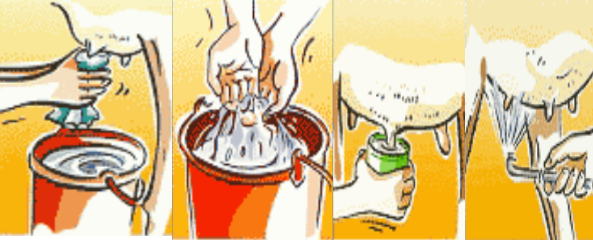The Myth that Milk is Essential for The Bones.

The Myth that Milk is Essential for The Bones.
Milk is a highly mucus-forming food that can cause irritation and congestion throughout the gastrointestinal tract.
If regularly consumed, milk can leave an increasingly hardening and almost impermeable coating on the inside of the intestinal membranes.
This restricts the absorption of nutrients, including the calcium, magnesium, and zinc needed to form bones.
It is virtually impossible to treat people with natural medicines as long as they continue to clog up their digestive systems with milk or dairy foods;
The medicines are not able to penetrate the hardened layer of mucus in the intestines.
Most people wouldn’t drink milk if they weren’t so influenced by the myth that milk is essential for the bones.
If you are prone to Osteoporosis, or Osteoarthritis, then consider the following:
#01
- Cow’s milk may be very rich in calcium but its high calcium to magnesium ratio can make it difficult to absorb.
- In certain people or body types, the calcium may be deposited in places where it is not required,
- hence the development of calcification of bones and other parts of the body.
#02
- Most of the calcium contained in cow’s milk is bound by the milk chemical casein, which makes it far too crude for proper absorption by the human intestinal membranes.
- Cow’s milk contains 300 times more casein than human milk.
- You can get more absorbable calcium out of 6-8 almonds or a teaspoon of molasses than you can get from one litre of cow’s milk.
#03
- There is quantitatively more phosphorus in cow’s milk than calcium.
- To metabolize that much phosphorus, the body requires extra amounts of calcium, which it extracts from the bones, teeth, and muscles.
- This leads to a calcium deficiency in these parts of the body.
- To compensate for the sudden loss of calcium, the body tries to mobilize more of it.
- As mentioned before, it has several methods to manufacture the much-needed mineral.
- If the body depended totally on external supplies of calcium, 80% of today’s population would have lost at least one third of their bone mass by the age of 30.
- Because of this self-regulating mechanism, we can survive even extremely one-sided diets with very little calcium intake.
- We can even fast on distilled water for long periods without developing a calcium deficiency.
- Yet if the consumption of dairy foods continues for a long time, the calcium reserves get depleted faster than they can be replenished, leading to damage to the bone tissue.
#04
- Milk proteins contain about three times as many sulphur-containing amino acids as proteins of vegetable origin.
- Through regular consumption of milk and dairy products, the blood would become too acidic if the body didn’t mobilize large amounts of minerals to save the body from acid death.
- Yet, in the long term, this emergency measure leads to demineralization of the tissues and organs and subsequent acidosis.
#05
- Storage of excessive amounts of milk protein in the connective tissues and basement membranes of the capillaries reduces the diffusion of essential minerals and vitamins to the tissues of the body.
- This causes a depletion of nutrients in the tissues, especially those that form the bones and joints.
Cows maintain strong and hardy bones and teeth throughout their lives and get most of their calcium from the greens they eat.
Gorillas, elephants, and other strong animals too do not suffer from osteoporosis.
Occasionally they lick on limestone but this is certainly not enough to supply the large quantities of calcium they require to build and rebuild their heavy skeletons.
If milk were the most useful and important source of calcium for grown animals then nature would certainly have designed ways of supplying them with milk throughout their lives.
But as it turns out, they have access to milk only at the beginning stages of their lives.
To digest whole milk the human body requires large amounts of bile.
Drinking whole milk regularly can eventually exhaust the liver’s bile-producing capacity.
Drinking low-fat milk makes matters even worse.
Low-fat milk requires less bile to digest the fat contained in the milk, yet milk protein cannot be digested without the natural amounts of milk fat.
Added to that, without sufficient bile, calcium cannot be properly digested or absorbed either.
The large amounts of undigested milk protein increase acidity in the body and the unused crude milk calcium can cause calcification of joints, arteries, or kidneys.
This can make protein foods with lowered fat content hazardous to health.
Leafy green vegetables contain four times more calcium than whole milk.
There is also plenty of calcium in almonds, black molasses, sesame seeds, broccoli, Brazil nuts, millet, oats, and citrus fruits.
The difference with this type of calcium is that it is readily absorbed by the human digestive system, provided the digestive system functions efficiently.
Osteoporosis or Osteoarthritis are metabolic disorders that are caused by severe congestion and an unbalanced diet/lifestyle, and rarely by insufficient calcium intake.
Osteoporosis is virtually unknown in places such as Africa where people eat far fewer proteins than those living in developed countries.








